5 First-String (but Second-Fiddle) Baseball Cards
Runners-up to greatness sometimes get lost in the glare
Bobby Bonilla turns 62 years old today. That feels like a big number for those of us who watched him play back when there was serious debate about who the bigger prospect/star was for the Pirates: Bobby Bo or Barry Bonds?
Sounds like a silly debate now, but Bonilla was pulling MVP votes two years before Bonds copped his first. And there were plenty of pundits who believed Bonilla’s defection to the Mets before the 1992 season would spell doom for the Bucs.
Not so much.
Things sure did take a turn for the worse in Pittsburgh in 1993 after Barry left, though. Looking back now, it’s pretty clear Bonds was the main man at Three Rivers all along.
But Bonilla and his big day (no, not Bobby Bonilla Day — that’s something different) at least give us a chance to take in some great vintage cardboard. Below, then, are five baseball cards of the second-best player on some good-to-great teams of yesteryear.
As always, I reserve the right to take some liberties with my definitions and designations. You have been warned.
1967 Topps George Scott (#75)
Already a superstar heading into 1967, Carl Yastrzemski cemented his Fenway legend that summer by picking up the gauntlet Frank Robinson threw down the year before. Not only did Yaz win the American League Triple Crown, but he also led the majors in home runs and RBI, won a Gold Glove in left field, and capped the festivities by hitting an even .400 with three home runs in the World Series.
It was hardly his fault that Boston fell to the Cardinals in seven games.
But then, Yaz wasn’t singlehandedly responsible for the A.L. pennant, either, despite his gobstopping 12.5 WAR. Indeed, the Impossible Dream Red Sox spent every day from August 20 through September 30 anywhere from a game-and-a-half up to a game-and-a-half down. Only a 5-3 win over the Twins and a Detroit loss on the last day of the season sent Boston to the Fall Classic.
The Red Sox needed every one of their wins, in other words, and pretty much every one of their runs. Luckily, they got strong supporting contributions up and down the lineup (Rico Petrocelli, Tony Conigliaro, Reggie Smith, Mike Andrews), the bench (Jerry Adair), and the pitching staff (Jim Lonborg, Lee Stange, John Wyatt).
But, whether you prefer traditional stats, Sabermetrics toys, or some combination, the best non-Yaz guy on that team was young first baseman George Scott. Just 23 years old at the time, Scott hit .303 with 19 home runs and 83 RBI while playing 159 games and even stealing 10 bases. He finished runner-up to Yaz in all those categories except SB, where he and Captain Carl tied behind Smith’s 16 swipes.
Scott doesn’t look quite like the grisled, burly Brewers slugger our baseball cards would reveal in the 1970s, but his 1967 Topps card up there is a crisp, clean hobby classic. The necklace made of the teeth of second basemen would have to wait a few years.
1980 Topps Manny Trillo (#90)
OK, so let me say right up front that this one is both a bit of a hedge and relies on WAR to get us where we need to be. Which is staring at an eye-of-the-tiger Manny Trillo in his Phillies warmup jacket taking his hacks in the batting cage on his 1980 Topps baseball card.
Doesn’t take much imagination to turn this into the Phils’ second baseman putting in the reps that would eventually help the team win their first-ever World Series title that fall. Right?
Between the first sighting of this chilly Trillo card and the last out of the Fall Classic, Trillo cranked out probably his best overall season. In 141 games, he hit .292 with seven home runs and 43 RBI, along with 25 doubles and nine triples. He was also good-to-great in the field and could have won a second Gold Glove without causing too much heartburn.
Trillo also hit .381 in the NLCS before falling to .217 in the World Series.
Add it all together (well, not the postseason stuff), and you have a player worth 3.4 WAR (Baseball Reference version), second among Phillies position players behind only Mike Schmidt.
And, yes, Steve Carlton topped the Phils’ overall WAR standings, and Tug McGraw landed above Trillo, but we’re ignoring pitchers here as part of our hedge.
From there, Trillo played a couple more seasons for the Phillies and then split the next seven seasons among five different major league teams. He was never again quite as impactful as he had been in 1980, and he never regained his runner-up status.
1982 Topps Traded Chet Lemon (#62T)
Willie Hernandez won the 1984 American League and Cy Young Awards but you’d be hard-pressed to make the case that he was the Tigers’ best player that storybook season. He did have a great campaign, going 9-3 with a 1.92 ERA and 32 saves, while appearing in a majors-high 80 games (and finishing 68 of them).
Still, Hernandez had joined an already star-laden group just the previous offseason, traded by the Phillies with Dave Bergman to Detroit, who sent Glenn Wilson and John Wockenfuss to Philly.
In the Motor City, Hernandez stepped in as closer, leaving Aurelio Lopez as a stud setup man. All the two of them (plus Doug Bair and a few others) had to do was take the ball from starters like Jack Morris, Dan Petry, Milt Wilcox, Juan Berenguer, and Dave Rozema to protect leads generated from the bats of Alan Trammell, Lou Whitaker, Lance Parris, Kirk Gibson, Howard Johnson, and others.
Chief among the “others” was Chet Lemon, who had come over from the White Sox (for Steve Kemp) after the 1981 season. Lemon appeared on his first Tigers card the next fall in the 1982 Topps Traded set, by which point he was already treating the Detroit faithful to the sort of powerful swings you see above.
A two-time All-Star in Chicago, Lemon tied a then-career-high with 19 homers his first summer in Motown, then upped the ante to 24 in 1983. In 1984,when the Tigers turned in an all-time team performance, Lemon hit .287 with 20 home runs and 76 RBI while playing a set-it-and-forget-it brand of All-Star centerfield…and he did, indeed, make his third (and final) All-Star cut.
That all added up to 6.2 WAR on the season, behind Trammell’s 6.8 and ahead of Gibson’s 5.1 and Hernandez’s 4.8. It was a slot —runner-up on the Tigers’ WAR list—that Lemon had also filled in 1983, even though he was consistently overlooked by collectors and fans outside of Detroit.
Still is.
1987 Topps Bobby Bonilla (#184)
Our man of the hour.
The Pirates originally signed Bonilla as an amateur free agent in 1981 before losing him to the White Sox in the Rule 5 draft late in 1985. The switch hitter came “home” to Pittsburgh the next July, though, when the Bucs sent Jose DeLeon to the ChiSox.
That set the stage for Bonilla to step into the lineup with another young could-be star named Barry Bonds. Of course, Bonds came with a fair amount of hype, seeing as how he was Bobby Bonds’ son and Willie Mays’ godson. There had to be a lot of talent in that bat and those legs, arms, and head, right?
Right, as it turned out.
But early on, and especially in those pre-SABR days, Bonds didn’t excite fans as a whole, and collectors in particular, all that much. As a rookie in 1986, for instance, he stole 36 bases but hit “just” 16 homers and batted a lowly .223. The next couple seasons were a bit more encouraging, with Bonds going 20-20 in 1987 and raising his average to .283 in 1988.
A step back to .248 with 19 homers, 58 RBI, and 32 stolen bases in 1989, though, had plenty of folks pointing to Bonilla as the best player on the team. After all, Bonilla hit .281 with 24 homers and 86 RBI that same summer after smacking 24 and an even 100 ribbies in 1988.
It wasn’t until 1990, when the Pirates won a division title and Bonds won his first MVP award, that folks started to appreciate Barry’s all-around game. And even then, Bonilla finished runner-up in National League MVP voting. There was still plenty of debate when Bonilla left for the Mets as a free agent in December 1991, with Bonds scheduled to come up for bidding a year later.
Who would be the bigger loss for the Pirates?
Well, Pittsburgh won a third straight division title in 1992 with Bonds still in the fold and Bonilla gone to a division rival, then cratered to fifth in the old National League East in 1993 — after Bonds defected to the Giants, that is.
Looking back at the stats now, it’s pretty clear that Bonilla was a solid #2 to Bonds for several seasons, with Andy Van Slyke, Jay Bell, and even Doug Drabek (on the pitcher side) entering the fray for that title as the Bucs ramped up their mini dynasty.
That clarity helped sort out the rookie cards of the Killer B’s, too. That woodgrain 1987 Topps Bonilla RC up there once stood toe-to-toe with the Bonds card from the same issue, both causing collector hearts to flutter. Now…well, the Bobby Bo entry is more likely to invite finger-pointing at the Mets and their deferred money than oohs and aahs from hobbyists.
1988 Topps Big Dave Henderson (#131)
From 1986 through 1992, the road to the World Series went through one man — Dave Henderson.
His October heroics for the 1986 Boston Red Sox are legendary, of course, and he followed that up by helping the 1987 Giants cap off their division title. Hendu came to San Francisco in a trade on September 1 and missed the postseason roster, but he was there when the Giants clinched the old N.L. West.
That offseason, Henderson signed a free agent deal with the Oakland A’s and settled in as the regular centerfielder for the next four seasons. During that time, the A’s won three American League pennants (1988 through 1990) and a World Series (1989) while Henderson continued to deliver lasting October memories.
The 1991 season didn’t pan out so well for the A’s, but they were back on top of the A.L. West in 1992. By that time, Hendu was a part-timer and would be gone to the Royals after the 1993 season.
But in his prime years with the A’s, Henderson was a force to be reckoned with, and much more than just an October highlight reel. In 1988, for example, when Jose Canseco left the baseball world breathless as the sport’s first 40-40 man, Henderson hit .304 with 24 home runs and 94 RBI. That amounted to a career-high 6.3 WAR, second on the team to Canseco’s 7.3.
It was a BIG year for Henderson, so why not celebrate a Topps Big card? No reason I can think of, so there you have it (up there).
With Rickey Henderson back in the fold the next year (1989), Dave Henderson battled Carney Lansford for the title of “Second Best A’s position player.” Hendu faded from the limelight (but not in production) a bit in 1990 as Rickey, Canseco, Mark McGwire, and Dave Stewart all put up big years before D. Henderson himself emerged as perhaps Oakland’s best player during a down year for the team in 1991.
So remember — if you ever find yourself in a time machine set for the last half of the 1980s or the early 1990s and your fortunes depend on October baseball somehow…follow the Hendu trail.
—
There are as many “second fiddle” players in baseball history as there are team seasons, and most of them offer plenty of room for debate. Who are some of your favorite runner-up batters (or pitchers, or overalls, if you prefer)?
Love to hear them.
Thanks for reading.
—Adam


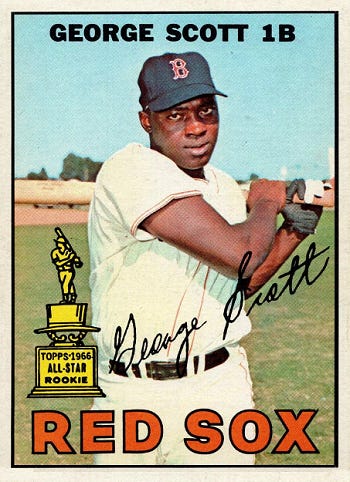
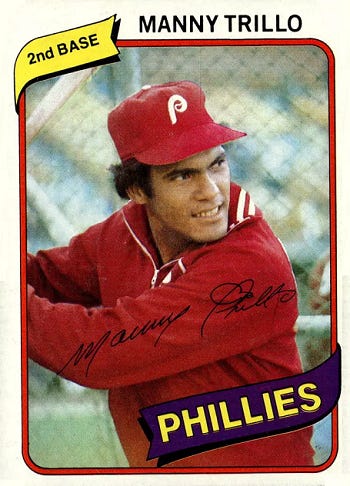
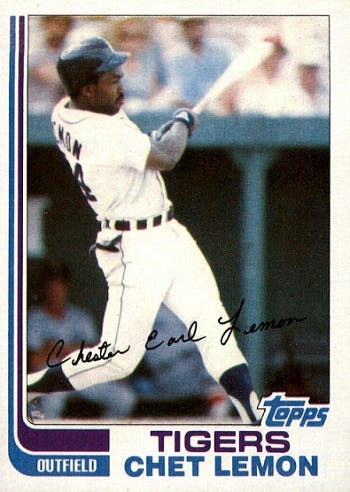
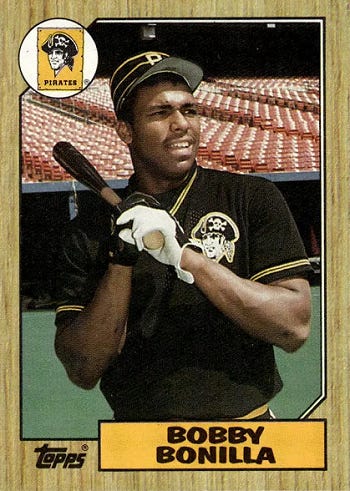
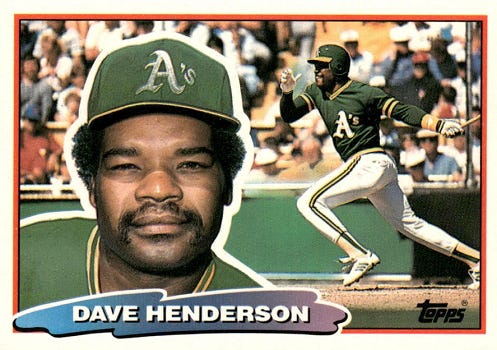
The Boomer!
Great stuff. Love the Chet Lemon mention as well. I’ll go with Luis Arroyo to Whitey Ford in 1961. Arroyo saved 13 of Ford’s 25 wins that year. Ford also had Arroyo come up with him for his Cy Young acceptance speech and had Arroyo finish it that year along with taking him on the commercials that came Ford’s way.